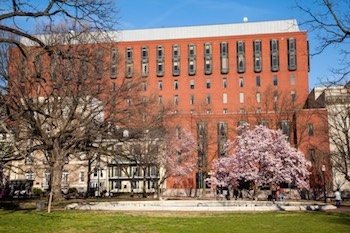 SAS Inst., Inc. v. ComplementSoft, LLC (Fed. Cir. June 10, 2016) (Before Chen, Newman, and Stoll, J.) (Opinion for the court, Stoll, J.) Click Here for a copy of the opinion.
SAS Inst., Inc. v. ComplementSoft, LLC (Fed. Cir. June 10, 2016) (Before Chen, Newman, and Stoll, J.) (Opinion for the court, Stoll, J.) Click Here for a copy of the opinion.
SAS petitioned for Inter Partes Review of a patent owned by ComplementSoft on a software development environment that included diagrams of “data flows” for use with “data manipulation languages.” The Patent Trial and Appeal Board (“Board”) instituted an IPR on some, but not all of the claims in the patent. At the conclusion of the proceeding, the Board found that all but one of the claims was invalid over the prior art. Claim 4 was patentable because the prior art did not satisfy the “data flows” limitation, under the Board’s construction. However, the construction of “data flows” adopted by the Board in its final decision differed from its construction in the institution decision. Neither party had argued for, or rebutted the Board’s construction, but assumed that the Board’s construction in the institution decision was effectively final. The Federal Circuit affirmed the Board’s claim constructions, but vacated the Board’s final decision because the parties had not been given the opportunity to argue for or against the Board’s newly-presented construction of “data flows.”
First, the Court affirmed the Board’s construction of the term “data flows” as “a graphical representation comprised of icons depicting data processing steps and arrows to depict the movement of data through source code.” SAS argued that the construction was unduly narrow, and could not be the “broadest reasonable interpretation” of the claim term. However, the Court emphasized that, even under this standard, the correct construction must be “reasonable.” Here, the Board’s construction was consistent with the specification’s use of “data flow diagram” and “graphical representation of data flow,” and thus corresponded to how a person of ordinary skill in the art would interpret the claim term.
[Troutman-Ad]
Second, the Court affirmed the Board’s construction of the term “data manipulation language.” ComplementSoft argued that object-oriented languages should be excluded from the scope of the claims because it distinguished a prior art reference during prosecution which used an object-oriented language. The Court disagreed, because there was no clear and unmistakable disclaimer of claim scope. In particular, while it was true that the prior art reference during prosecution disclosed a similar system with an object-oriented language, the prior art reference applied during the IPR used Select Query Language (SQL), which is specifically identified in the specification as “data manipulation language” even though it is object-oriented. Thus, whatever the scope of the prosecution disclaimer may be, it did not exclude SQL from the scope of the claims.
Third, the Federal Circuit held that the Board’s changed claim construction of “data flow,” violated the Administrative Procedure Act (APA), even if it was correct. In particular, it deprived the petitioner of the procedural protections of the APA, which prohibits an agency from changing legal theories during a proceeding without giving respondents notice of the change and the opportunity respond to the new theory. Because the Board changed its construction of the term “data flow” absent any suggestion from the parties, and without any notice, there was no meaningful opportunity to respond to the unanticipated change. Therefore, the Court vacated the decision of the Board to afford the parties an opportunity to present arguments on the Board’s newly-adopted construction of “data flow.”
Fourth, the Court affirmed that the Board’s final written decision did not need to address every patent claim challenged in the original IPR petition. There is no statutory requirement that the Board’s final decision address every claim in a petition for IPR. In particular, the statute dictating the contents of a final decision only requires the Board to address claims that are actually reviewed. In contrast, the statute governing institution decisions describes claims challenged in the petition. Thus, the PTO’s regulations that allow a petition to be instituted in part, and the written decision only to address the instituted grounds, is a reasonable implementation of these statutes.
Judge Newman dissented in part, reasoning that the PTO regulation allowing the Board to review some, but not all, claims in the patent departs from the America Invents Act (AIA) statutory plan. For example, when the Board invalidates some claims, affirms the patentability of others, and refusing to institute IPR on others. The IPR provisions of the AIA were intended to reduce the burden of patent litigation by providing a less expensive and alternative venue for validity disputes. However, this incomplete review at the Board’s sole discretion imposes “additional delay, uncertainty, and cost,” thereby undercutting the AIA’s purpose of expedition and economy.
Parker Hancock and Puja Dave also contributed to this case summary.
[Troutman-About]

![[IPWatchdog Logo]](https://ipwatchdog.com/wp-content/themes/IPWatchdog%20-%202023/assets/images/temp/logo-small@2x.png)


![[Advertisement]](https://ipwatchdog.com/wp-content/uploads/2024/04/Patent-Litigation-Masters-2024-sidebar-early-bird-ends-Apr-21-last-chance-700x500-1.jpg)

![[Advertisement]](https://ipwatchdog.com/wp-content/uploads/2021/12/WEBINAR-336-x-280-px.png)
![[Advertisement]](https://ipwatchdog.com/wp-content/uploads/2021/12/2021-Patent-Practice-on-Demand-recorded-Feb-2021-336-x-280.jpg)
![[Advertisement]](https://ipwatchdog.com/wp-content/uploads/2021/12/Ad-4-The-Invent-Patent-System™.png)







Join the Discussion
No comments yet.